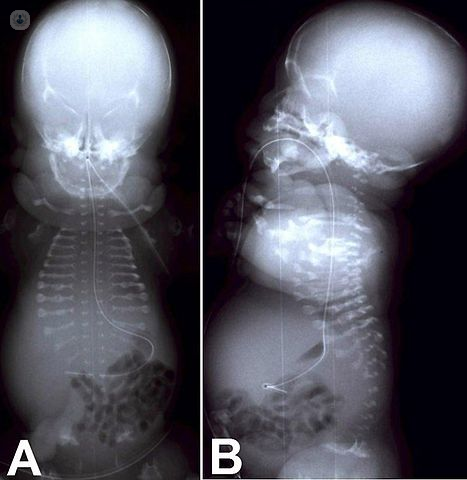

What is skeletal dysplasia?
A skeletal dysplasia is a problem with the way that bones grow and develop. There are over 200 types of skeletal dysplasia, affecting 1 in 4,000 births .
The most common types of skeletal dysplasia areachondroplasia, achondrogenesis,thanatophoric dysplasia, and osteogenesis imperfecta.
Symptoms of skeletal dysplasia include:
- short arms and legs
- short fingers
- a disproportionately large head
- limited mobility at the elbows
- short neck
- overall short stature
Each type of skeletal dysplasia is characterised by a different set of abnormalities.

Prognosis of the condition
In some cases, skeletal dysplasia causes very abnormal bone growth. This stops the chest and lungs from properly developing, and babies with this condition cannot survive. This condition is known as lethal skeletal dysplasia and it occurs in about 1 in every 10,000 births .
Non-lethal skeletal dysplasia is a term that applies to babies who survive birth and the immediate aftermath. Among those with non-lethal skeletal dysplasia, achondroplasia is the most common diagnosis, and is often referred to as dwarfism.
How is skeletal dysplasia diagnosed?
Some types of skeletal dysplasia are noticed at around 20 weeks into pregnancy during an ultrasound scan, but other types might not be evident until early infancy. Even when skeletal dysplasia is noticed during pregnancy, it may be difficult to diagnose the exact type until after birth.
If skeletal dysplasia is detected during pregnancy, the doctor may consider further scans, such as a CT scan, in consultation with radiologists and obstetricians.
If you have a young child and you have only just started to notice problems with their growth, diagnosis may involve:
- a growth specialist nurse taking measurements
- tests such as X-rays or blood test
- an assessment of any other medical conditions your child has experienced.
What are the causes of skeletal dysplasia?
Skeletal dysplasia is generally a genetic condition, involving a gene mutation. Most children with skeletal dysplasia do not have parents with the condition.
Treatments for skeletal dysplasia
Skeletal dysplasia can cause a wide range of developmental problems. As a result, the team involved in your child’s care is likely to be diverse, and can include:
- orthopaedic surgeons
- geneticists
- cardiologists
- ear, nose and throat specialists
- ophthalmologists
- neurologists
- endocrinologists
- occupational therapists
Treatment can include:
- surgery to correct the spine, widen the spinal canal, correct the direction in which bones are growing, or lengthen limbs
- inserting a shunt to drain excess fluid from the brain
- physiotherapy to strengthen muscles and increase the range of your child’s movement
- occupational therapy to recommend assistive equipment and provide advice on alternative ways to accomplish day-to-day tasks
- counselling and psychological support
